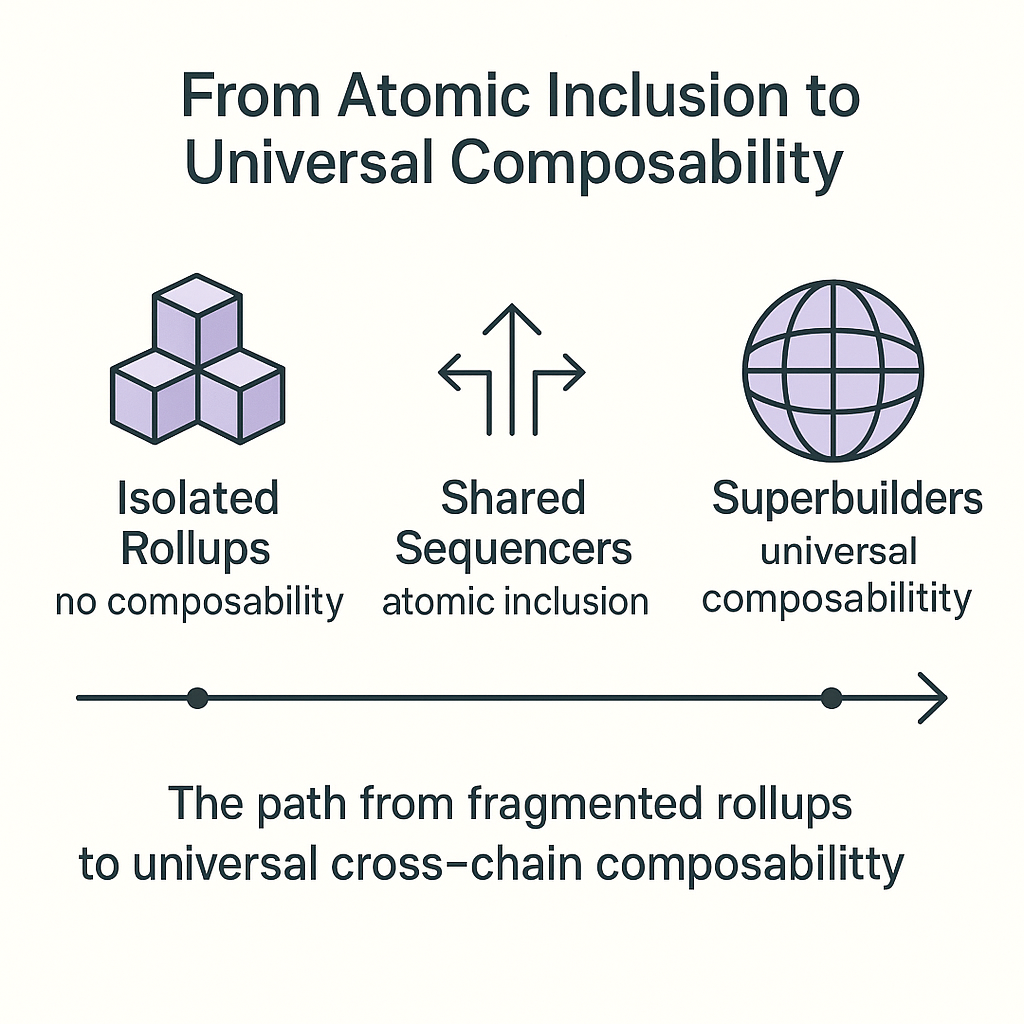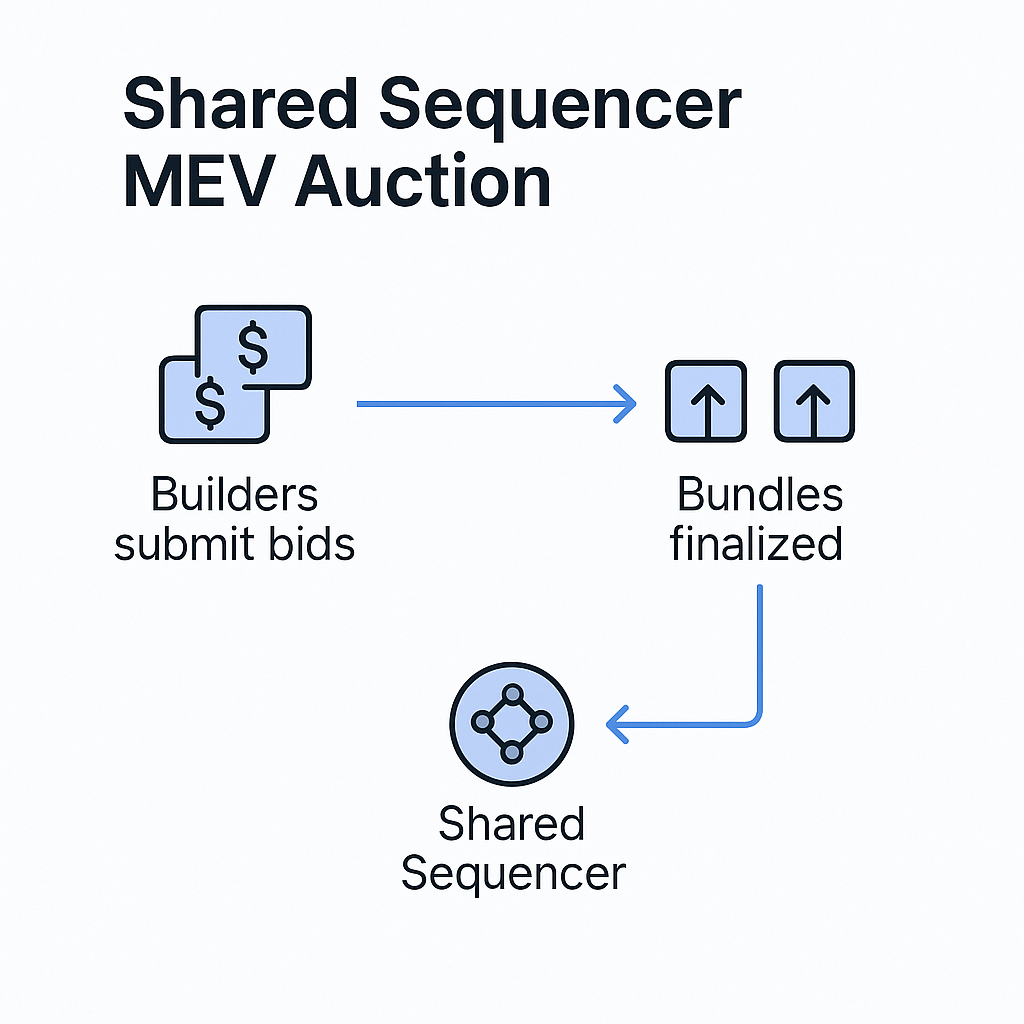Looking Ahead – Superbuilders and Universal Composability
This module explores the future trajectory of shared sequencer networks, focusing on the emergence of superbuilders, the potential for universal composability, and the broader implications for modular blockchain ecosystems. It synthesizes ongoing research, pilot implementations, and anticipated challenges as the technology matures.
The Concept of Superbuilders
The notion of a superbuilder arises from the limitations of current shared sequencer models. While atomic inclusion addresses ordering, it does not ensure state-aware execution across multiple rollups. A superbuilder is envisioned as an entity, or more accurately, a decentralized network of entities that aggregates transactions across multiple rollups, simulates their combined execution outcomes, and constructs bundles that are guaranteed to succeed atomically upon inclusion.
This architecture builds on lessons from Ethereum’s proposer‑builder separation (PBS) and emerging multi-domain MEV markets. In practice, a superbuilder would maintain synchronized state snapshots of connected rollups, enabling it to identify cross-rollup opportunities such as arbitrage, liquidations, or complex multi-protocol trades. By validating execution outcomes before submission, superbuilders could deliver true atomic composability, bridging the gap between isolated rollup environments and the seamless composability of monolithic chains.
From Atomic Inclusion to Universal Composability

Universal composability represents the next frontier in modular blockchain design. It implies not only atomic inclusion and execution but also consistent state coordination across multiple domains. In this model, applications would no longer be constrained by rollup boundaries; smart contracts could interact across chains as if they were on a single logical network.
Achieving universal composability requires several breakthroughs. First is efficient cross-rollup state verification: sequencers or builders must confirm that dependent transactions will succeed across heterogeneous virtual machines and proof systems without introducing prohibitive latency. Second is standardized messaging: rollups must adopt compatible protocols for state proofs, message formats, and dispute resolution. Finally, incentives must align to ensure that validators, builders, and rollups cooperate rather than compete in ways that fragment liquidity.
Research in 2024–2025 has begun to address these challenges. Projects like Espresso are experimenting with multi-domain state proofs that could enable atomic execution, while intent-centric protocols such as Anoma and SUAVE propose solver networks that abstract away chain boundaries entirely. These developments point toward a future where rollup proliferation does not imply composability loss, but instead fosters a more interconnected Web3 ecosystem.
Interplay with Data Availability and Restaking

The evolution of shared sequencer networks is closely linked to advances in data availability and restaking frameworks. Modular data layers such as Celestia, EigenDA, and Avail provide the foundation for lightweight rollups, but they also influence sequencing design. Sequencers must ensure that ordered transactions are published reliably to data layers, enabling trustless verification by rollup nodes.
Restaking solutions, popularized by EigenLayer, have emerged as a way to bootstrap security for new middleware layers, including sequencers. By rehypothecating staked ETH or other assets, sequencer networks can rapidly assemble economic guarantees without requiring participants to post entirely new capital. However, this approach introduces systemic risks: correlated slashing events or cascading failures could affect multiple middleware services simultaneously. Balancing security efficiency with isolation remains an open design question for future networks.
Implications for Developers and Users
For developers, the shift toward superbuilders and universal composability promises a simplified programming model. Instead of designing applications around asynchronous bridges and fragmented liquidity, developers could target a unified cross-rollup interface. This would enable more sophisticated financial products, multi-chain DAOs, and omnichain gaming experiences that leverage the unique strengths of different rollups without sacrificing user experience.
Users, in turn, would experience seamless cross-rollup interactions. A wallet could initiate a transaction involving lending on one rollup, swapping on another, and staking on a third without explicit bridging or manual coordination. Fees could be netted across chains, and settlement could occur atomically, reducing cognitive load and risk. This user experience aligns with broader trends in Web3 toward abstraction and intent-based architectures, where users specify outcomes rather than individual transaction steps.
Challenges on the Road Ahead
Despite the promise, several hurdles remain before superbuilders and universal composability become practical. The first is scalability: maintaining synchronized state for dozens of rollups in real time may require specialized infrastructure, including dedicated data pipelines and hardware acceleration. The second is security: superbuilders coordinating high-value cross-rollup bundles will become lucrative targets for MEV exploitation and bribery attacks, demanding robust cryptoeconomic safeguards and transparent governance.
Another challenge is standardization. Without widely adopted protocols for cross-rollup messaging and state proofs, fragmentation may persist, with competing ecosystems developing incompatible composability solutions. Efforts such as the Interop Alliance and Ethereum’s rollup-centric roadmap aim to foster alignment, but consensus across diverse stakeholders is difficult.
Finally, regulatory scrutiny is likely to increase. As sequencing and building functions consolidate across multiple domains, regulators may view these networks as critical infrastructure, subjecting them to oversight similar to centralized clearinghouses. Navigating compliance without undermining decentralization will be a delicate balancing act for network designers.
Future Outlook
The coming years are expected to see rapid experimentation in sequencing and composability architectures. Shared sequencer networks like Astria and Espresso are likely to expand validator sets and integrate with additional rollups, while intent-based protocols evolve toward generalized solver markets. If superbuilders succeed, the modular blockchain stack could achieve a new equilibrium: execution remains distributed, but composability approaches that of monolithic designs.
Such a future would redefine how developers and users perceive blockchain ecosystems. Rather than choosing a single chain for deployment or use, applications could fluidly span multiple rollups, selecting the best execution environment for each task while maintaining atomic guarantees. This vision, once theoretical, is now within reach as sequencing, data availability, and cross-rollup coordination converge.





